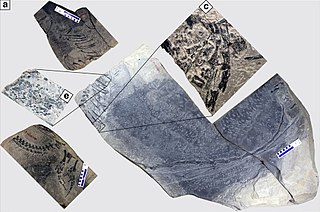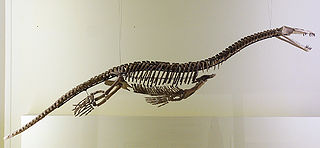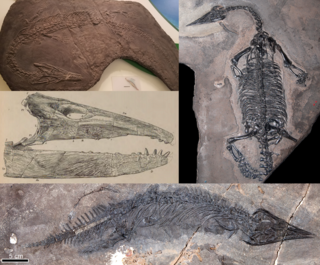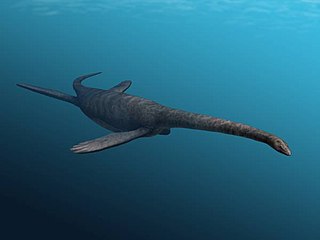Related Research Articles

Guiyang, historically rendered as Kweiyang, is the capital of Guizhou province of the People's Republic of China. It is located in the center of the province, situated on the east of the Yunnan–Guizhou Plateau, and on the north bank of the Nanming River, a branch of the Wu River. The city has an elevation of about 1,100 meters (3,600 ft). It has an area of 8,034 square kilometers (3,102 sq mi). At the 2020 census, its population was 5,987,018, out of whom 4,506,134 lived in the six urban districts.

Dinocephalosaurus is a genus of long necked, aquatic protorosaur that inhabited the Triassic seas of China. The genus contains the type and only known species, D. orientalis, which was named by Li in 2003. Unlike other long-necked protorosaurs, Dinocephalosaurus convergently evolved a long neck not through elongation of individual neck vertebrae, but through the addition of neck vertebrae that each had a moderate length. As indicated by phylogenetic analyses, it belonged in a separate lineage that also included at least its closest relative Pectodens, which was named the Dinocephalosauridae in 2021. Like tanystropheids, however, Dinocephalosaurus probably used its long neck to hunt, utilizing the fang-like teeth of its jaws to ensnare prey; proposals that it employed suction feeding have not been universally accepted. It was probably a marine animal by necessity, as suggested by the poorly-ossified and paddle-like limbs which would have prevented it from going ashore.

Nothosaurus is an extinct genus of sauropterygian reptile from the Triassic period, approximately 240–210 million years ago, with fossils being distributed from North Africa and Europe to China. It is the best known member of the nothosaur order.

Thalattosauria is an extinct order of prehistoric marine reptiles that lived in the middle to late Triassic period. Thalattosaurs were diverse in size and shape, and are divided into two superfamilies: Askeptosauroidea and Thalattosauroidea. Askeptosauroids were endemic to the Tethys Ocean, their fossils have been found in Europe and China, and they were likely semiaquatic fish eaters with straight snouts and decent terrestrial abilities. Thalattosauroids were more specialized for aquatic life and most had unusual downturned snouts and crushing dentition. Thalattosauroids lived along the coasts of both Panthalassa and the Tethys Ocean, and were most diverse in China and western North America. The largest species of thalattosaurs grew to over 4 meters (13 feet) in length, including a long, flattened tail utilized in underwater propulsion. Although thalattosaurs bore a superficial resemblance to lizards, their exact relationships are unresolved. They are widely accepted as diapsids, but experts have variously placed them on the reptile family tree among Lepidosauromorpha, Archosauromorpha, ichthyosaurs, and/or other marine reptiles.

Qianichthyosaurus is an extinct genus of ichthyosaur from the Ladinian and Carnian stages of the Late Triassic epoch. Its fossils have been found in southeastern China, in Carnian rocks of the Falang Formation near Huangtutang, Guizhou. The type species is Qianichthyosaurus zhoui, named by Chun Li in 1999. A second species, Qianichthyosaurus xingyiensis, was named from older (Ladinian) deposits in the Falang Formation in 2013 by Pengfei Yang and colleagues. Complete Qianichthyosaurus fossils are common in the Xiaowa Formation, with both juveniles and pregnant specimens being known; its larger contemporaries, Guizhouichthyosaurus and Guanlingsaurus, are rarer.

Sinosaurosphargis is an extinct genus of basal marine saurosphargid reptile known from the Middle Triassic Guanling Formation of Yunnan and Guizhou Provinces, southwestern China. It contains a single species, Sinosaurosphargis yunguiensis.

Anshunsaurus is a genus of thalattosaurs within the family Askeptosauridae. Fossils have been found from Middle Triassic deposits in Guizhou, China. Three species are known: the type species A. huangguoshuensis, the slightly older species A. wushaensis, and the species A. huangnihensis.

Thalattosauroidea is a superfamily of thalattosaurs, a Triassic group of marine reptiles. It was named in 1904 by paleontologist John Campbell Merriam to include the genus Thalattosaurus from California. Thalattosauroids are one of two groups of Thalattosauria, the other being Askeptosauroidea. Thalattosauroids make up the "traditional" thalattosaurs with large downturned snouts, short necks, and long, paddle-like tails.

Wumengosaurus is an extinct aquatic reptile from the Middle Triassic Guanling Formation of Guizhou, southwestern China. It was originally described as a basal eosauropterygian and usually is recovered as such by phylogenetic analyses, although one phylogeny has placed it as the sister taxon to Ichthyosauromorpha while refraining from a formal re-positioning. It was a relatively small reptile, measuring 95.5–130.5 cm (3.13–4.28 ft) in total body length and weighing 6 kg (13 lb).

Yunguisaurus is an extinct genus of pistosaur known from the Guizhou Province of China.

Psephochelys is an extinct genus of placodont reptile from the Late Triassic of China. It is represented by a single species, Psephochelys polyosteoderma, named in 2002 on the basis of a single partial skeleton found in an outcrop of the Carnian-age Falong Formation in Guizhou Province. Psephochelys is classified as a member of the family Placochelyidae, which is within the larger placodont superfamily Cyamodontoidea. Like other cyamodontoids, Psephochelys has a wide shell covering its body, similar to that of a turtle. However, unlike those of other cyamodontoids, the shell of Psephochelys only covers its back. The plastron, which covers the underside of other cyamodontoids, is absent, and in its place are rib-like gastralia surrounded by loosely connecting osteoderms or bony plates.

Blezingeria is an extinct genus of marine reptile from the Middle Triassic of Germany. The type and only species Blezingeria ichthyospondyla was named by German paleontologist Eberhard Fraas in 1896. It is known from many isolated bones that come from a deposit in southwestern Germany called the Upper Muschelkalk, which dates back to the Ladinian stage. The relationships of Blezingeria are uncertain. Fraas identified it as a nothosaur, but it has also been classified as a cymbospondylid ichthyosaur, and most recently a thalattosaur. Many thalattosaur fossils have been found in a slightly olderLate Ladinian-age rock unit in Monte San Giorgio, Switzerland, so if Blezingeria is a thalattosaur, it may represent an early stage in an evolutionary radiation of the group across the Tethys, an ocean that covered much of what is now Europe and southern China during the Triassic. However, since Blezingeria is known from very incomplete material, its classification as a thalattosaur remains uncertain.

Tholodus is an extinct genus of basal ichthyopterygian known from the Middle Triassic of Germany, northeastern Italy and possibly China. It was first named by Christian Erich Hermann von Meyer in 1851 and the type species is Tholodus schmidi. It is known from many disarticulated and fragmentary remains, mainly teeth and jaw fragments. Most specimens were collected from various localities across the Ladinian-aged Muschelkalk, Germany, mainly from the Jena Formation of the upper Lower Muschelkalk, where the holotype was found. Dalla Vecchia (2004) recently described two additional specimens, a mandibular ramus and a maxilla, both bearing teeth and nearly uncrushed, and some postcranial remains, from a single late Anisian outcrop, from the southern Alps of Italy. The humerus resembled that of immature individuals of the Asian genus Chaohusaurus, suggesting possible affinities to Grippidia.
Wangosaurus is an extinct genus of basal pistosauroid known from the Middle Triassic Falang Formation of Xingyi in Guizhou Province, southwestern China. It contains a single species, Wangosaurus brevirostris, first described and named by Le-Tian Ma, Da-Yong Jiang, Olivier Rieppel, Ryosuke Motani and Andrea Tintori in 2015. The specific name brevirostris comes from Greek for "short snout". It is known solely from its holotype, a nearly complete and articulated skeleton measuring 2.2 m (7.2 ft) long.
Sanchiaosaurus is an extinct genus of a basal nothosauroid known from the Middle Triassic of Guizhou Province, southwestern China. It contains a single species, Sanchiaosaurus dengi.
Litorosuchus is a genus of armored, semiaquatic archosauriform reptile from the Middle Triassic of China, closely related to the morphologically similar Vancleavea. It contains one species, L. somnii.

Pectodens is an extinct genus of archosauromorph reptile which lived during the Middle Triassic in China. The type and only species of the genus is P. zhenyuensis, named by Chun Li and colleagues in 2017. It was a member of the Archosauromorpha, specifically part of the unnatural grouping Protorosauria. However, an unusual combination of traits similar and dissimilar to other protorosaurs initially led to confusion over its evolutionary relationships. In 2021, it was placed in a newly-established group, Dinocephalosauridae, along with its closest relative Dinocephalosaurus.
The Xiaowa Formation is a Carnian-age geological formation found in southern China. It is a sequence of limestone and marls from the Carnian stage of the Triassic. Its lower section was previously known as the Wayao Formation or Wayao Member of the Falang Formation. In 2002, the Wayao Member was renamed and raised to the Xiaowa Formation to prevent confusion with an Eocene unit of the same name. Crinoids and marine reptiles are abundant in the Xiaowa Formation, forming a lagerstätte known as the Guanling biota. Ammonoids and conodonts found in the formation constrain its age to the early Carnian. Reptiles of the Guanling biota include ichthyosaurs, thalattosaurs, placodonts, and Odontochelys. Sedimentary events within this formation have been tied to the Carnian Pluvial Event.
The Yangliujing Formation is a Middle Triassic geologic unit found in the Guizhou and Yunnan Provinces of southern China.
Qingyan is a town in Huaxi, Guiyang, Guizhou, China.
References
- ↑ E. Strand. 1928. Miscellanea nomenclatorica zoologica et palaeontologica. Archiv für Naturgeschichte, Abteilung A, pages 30-75
- ↑ H.-F. Yin and E. L. Yochelson. 1983. Middle Triassic Gastropoda from Qingyan, Guizhou Province, China: 1 - Pleurotomariacea and Murchisoniacea. Journal of Paleontology 57(1):162-187